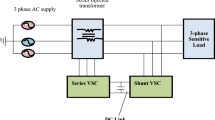Abstract
The efficiency and operation of current distribution systems have been enhanced by the insertion of renewable distributed generation (RDG). However, the placement of DG does not satisfy the network’s need for reactive power, which keeps the voltage of the buses at a level that maximizes the uncontrolled real and reactive variations of power systems. This paper proposed the optimal allocation of DG and Unified Power Quality Conditioner (UPQC) simultaneously to improve the performance of an active distribution system. The most advanced custom power device is the UPQC which combined with the capability of shunt and series compensator features allows for voltage and current compensation in distribution systems. A suitable optimization method is needed to address the challenge of selecting the capacity and position of these compensators. The Firefly Algorithm (FA) is a promising solution to the challenges of multi-objective optimization. The intended objective is active and reactive power loss reduction while improving the voltage profile without violating any system constraints. The effectiveness of the proposed optimal allocation of DG/UPQC using the FA method was evaluated by comparing it to the allocation of the DG system only and the base case system scenarios, respectively. The results revealed a significant percentage reduction in active and reactive power losses, reaching 72.01% and 66.57% with the optimal DG/UPQC allocation combination, respectively. In comparison to the Artificial Bee Colony Optimization (ABC) method, the results revealed the FA method is more efficient regarding both convergence speed and solution quality. The MATLAB 2021b environment served as the platform for the simulation, and it was tested it using the IEEE 33-bus radial distribution system method.
Access this chapter
Tax calculation will be finalised at checkout
Purchases are for personal use only
Similar content being viewed by others
References
Machowski J, Bialek JW, Bumby JR (2011) Power system dynamics: stability and control. John Wileys & Sons, Ltd. https://doi.org/10.1007/978-1-4471-2291-3_5
Sambaiah KS (2018) A review on optimal allocation and sizing techniques for DG in distribution systems. Int J Renew Energy Res 8:1236–1256
Shuaibu Hassan A, Sun Y, Wang Z (2020) Optimization techniques applied for optimal planning and integration of renewable energy sources based on distributed generation: recent trends. Cogent Eng 7
Kadam PM, Kushare BE (2017) A survey on unified power quality conditioner for power quality improvement. In: National conference on emerging trends in engineering & technology, pp 2320–3331
Farhoodnea M, Mohamed A, Shareef H, Zayandehroodi H (2012) A comprehensive review of optimization techniques applied for placement and sizing of custom power devices in distribution networks. Prz Elektrotechniczny 88:261–265
Ramanaiah ML, Reddy MD (2018) Moth flame optimization method for unified power quality conditioner allocation. Int J Electr Comput Eng 8:530–537
Taher SA, Afsari SA (2012) Optimal location and sizing of UPQC in distribution networks using differential evolution algorithm. Math Prob Eng 2012
Musa U, Mati AA, Mohammed A, Mas AA (2020) Implementation of bacterial foraging algorithm based model for unified power quality conditioner placement in a practical distribution feeder. Coven J Eng Technol 4:49–65
Jayalakshmi D, Sankar S, Venkateshkumar M (2019) An analysis of load management system by using UPQC for distribution network. Emerging trends expert application and security advance intelligence system computer, vol 841. Springer Singapore, pp 261–272
Dehnavi E, Afsharnia S, Gholami K (2019) Optimal allocation of unified power quality conditioner in the smart distribution grids. Electr. Eng. Springer 101:1277–1293
Yuvaraj T, Ravi K, Devabalaji KR (2017) Optimal allocation of DG and DSTATCOM in radial distribution system using cuckoo search optimization algorithm. Model. Simul. Eng. 2017
Yuvaraj T, Devabalaji KR, Thanikanti SB (2019) Simultaneous allocation of DG and DSTATCOM using whale optimization algorithm. Iran J Sci Technol Trans Electr Eng 0123456789
Frahat M, Hatata AY, Saadawi MM, Kaddah SS (2022) Grasshopper optimization-based optimal sizing of DG/DSTATCOM in distribution networks. MANSOURA Eng J 47:6–16
Hariprasad C, Kayalvizhi R, Karthik N (2022) Optimum restructuring of radial distribution network with integration of DG and DSTATCOM using artificial fish swarm optimization technique. In: International conference on sustainable energy and future electric transportation. IEEE, pp 4–6. https://doi.org/10.1109/SeFeT55524.2022.9909394
Durbhaka GK, Selvaraj B, Nayyar A (2019) Fire fly swarm : metaheuristic swarm intelligence technique for mathematical optimization. Springer Singapore. https://doi.org/10.1007/978-981-13-1274-8
Iqbal F, Khan MT, Siddiqui AS (2018) Optimal placement of DG and DSTATCOM for loss reduction and voltage profile improvement. Alex Eng J 57:755–765
Singh B, Chandra A, Al-Haddad K (2015) Power quality: problems and mitigation techniques (Book News). IEEE Ind Electr Mag. 9
Raj AF, Saravanan AG (2023) An optimization approach for optimal location & size of DSTATCOM and DG bus injection to branch current. Appl Energy 336:120797
Yang XS (2009) Firefly algorithms for multimodal optimization. Lect Notes Comput Sci (including Subser Lect Notes Artif Intell Lect Notes Bioinformatics) 5792:169–178
Yang XS (2010) Firefly algorithm, stochastic test functions and design optimization. Int J Bio-Inspired Comput 2:78–84
Vita V (2017) Development of a decision-making algorithm for the optimum size and placement of distributed generation units in distribution networks. Energies. https://doi.org/10.3390/en10091433
Author information
Authors and Affiliations
Corresponding author
Editor information
Editors and Affiliations
Rights and permissions
Copyright information
© 2024 The Author(s), under exclusive license to Springer Nature Singapore Pte Ltd.
About this paper
Cite this paper
Mustapha, M., Rasid, M.B.M., Jamian, J.J.B., Bakare, G.A., Haruna, Y.S. (2024). Deployment of Renewable Embedded Generation and Unified Power Quality Conditioner in Distribution System using Firefly Algorithm. In: Malik, H., Mishra, S., Sood, Y.R., Iqbal, A., Ustun, T.S. (eds) Renewable Power for Sustainable Growth. ICRP 2023. Lecture Notes in Electrical Engineering, vol 1086. Springer, Singapore. https://doi.org/10.1007/978-981-99-6749-0_24
Download citation
DOI: https://doi.org/10.1007/978-981-99-6749-0_24
Published:
Publisher Name: Springer, Singapore
Print ISBN: 978-981-99-6748-3
Online ISBN: 978-981-99-6749-0
eBook Packages: EnergyEnergy (R0)




